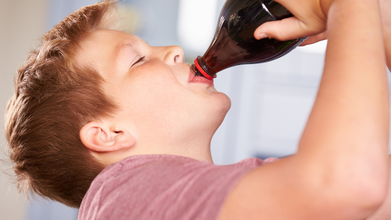- Health Conditions A-Z
- Health & Wellness
- Nutrition
- Fitness
- Health News
- Ayurveda
- Videos
- Medicine A-Z
- Parenting
- Web Stories
From Womb To The Cradle: Why Babies Find Rocking Relaxing?

Image Credits: Canva
Ever wonder why babies immediately relax when rocked? It's not merely a trick to comfort infants, it's science! From womb to crib, gentle motion calms their nervous system, enhances sleep, and even helps digestion. As a parent, you quickly understand that sleep is one of the most precious presents for you and your baby. Yet, getting a little one to fall and remain asleep is more often easier said than done. One of the oldest and most effective techniques for soothing infants is rocking—a motion that has been used across generations and cultures. But why do babies and young children find such deep comfort in being rocked? The answer lies in biology, neuroscience, and a bit of evolutionary instinct.
Since the earliest days of life, infants are subject to continuous motion. Within the womb, the subtle swaying brought about by a mother's movement creates a rhythmic and calming atmosphere for a growing fetus. This is mostly because of the natural respiratory movements of the mother, as the diaphragm contracts and relaxes, subtly moving the baby in a rocking motion.
This prenatal rocking is an important aspect of fetal development, regulating the nervous system of the baby and soothing his or her nerves. After birth, this familiar feeling does not go away. Instead, it remains a serious source of security and comfort. For this reason, babies tend to react so favorably when they are rocked back and forth in their parent's arms, swayed in a baby hammock, or bounced up and down in a cradle.
How Does Rocking Impact Baby's Brain?
Studies revealed that movement engages the vestibular system, one tasked with equilibrium and spatial perception. When being rocked, such a system gets triggered, resulting in signals reaching the brain to facilitate relaxation and sleepiness. Gently rocking babies has also been discovered to alter brain waves such that it copies the initiation stages of slumber, simplifying the act for babies.
In addition to putting babies to sleep, rocking activates the parasympathetic nervous system—the division of the nervous system that supports rest, digestion, and relaxation. This has the effect of decreasing stress hormones like cortisol while stimulating the production of calming neurotransmitters, including serotonin and dopamine. The end result? A quieter, happier baby who is better able to sleep through the night.
Benefits of Rocking for Infant's Sleep and Development
Rocking is not merely for assisting babies to sleep; it is beneficial in numerous other ways that support general well-being. Among the major benefits are:
1. Better Quality of Sleep
The rhythmical movement of rocking facilitates infants to move to a deeper sleep state. It is especially useful for newborns and infants, who spend a large part of their sleep phase in light sleep stages. Through deeper sleep, infants wake up less often and have more restful nights.
2. Minimized Sleep Disturbances
Because rocking emulates the feel of being inside the womb, it provides a soothing and safe place. It limits sleep interruption and facilitates it is simpler for infants to get across sleep patterns without waking altogether.
3. Improved Digestion and Relieved Colic
Several parents attribute their use of rocking to be the best colic soother, and research supports them. Gentle motion gets the digestive system going and keeps gas from accumulating, making digestion easier for the baby. It can be particularly helpful for babies with reflux or digestive upset.
4. Lower Stress and Anxiety
Rocking gives a soothing, rhythmic experience that facilitates babies in self-regulating their feelings. By lowering the levels of stress hormones and inducing relaxation, rocking makes babies feel secure, safe, and peaceful—a very important factor in healthy emotional growth.
Why Rocking Comforts Older Children Too
Although the requirement for constant rocking will lessen as a child becomes older, a lot of toddlers and even bigger children prefer soft motion. That is why rocking chairs, swings, and even slumbering car rides can be soothing to small children.
For kids with sensory sensitivities or neurodevelopmental disorders like autism, rocking may be especially helpful. The repetitive action aids in regulating sensory input, allowing a feeling of control and calm in potentially overwhelming settings.
Best Methods to Incorporate Rocking into Your Child's Daily Life
If you wish to benefit the most from rocking for your infant or young child, the following are some efficient methods to help include it as part of your day-to-day routine:
Baby Hammocks & Swings: These swing gently to imitate the comfortable motion of lying in the womb, and they are great resources for calming your baby and sending them off to sleep.
Rocking in Your Arms: Simply rocking your baby in your arms is the easiest and most comfortable method of calming them.
Rocking Chairs & Gliders: Ideal for reading bedtime stories or cuddles before a nap, rocking chairs offer comfort to both parent and child.
Babywearing: Carrying your baby in a sling or carrier while moving naturally throughout the day offers a continuous and comforting rocking motion.
There is a reason that rocking has endured as one of the most reliable ways to calm babies and toddlers. It acts on ancient biological impulses, activates the nervous system in a soothing manner, and offers several developmental advantages. Whether in a parent's arms, a crib, or a rocking chair, soft motion is an elemental and powerful source of solace for children everywhere.
Tips For New Moms To Stay A Step Ahead Of Breast Cancer, According To Doctor

Credits: Canva
As a new mom a lot of things run through in the head. Not just child's health, but also your health too. As it is a very new experience. One of the newest experience could be breast feeding, and the thought of breast cancer and many such questions may occur.
Is There Any Link Between Pregnancy And Breast Cancer?
As per the National Institutes of Health, US, the risk of breast cancer, is in fact reduced by 4.3% for every 12 months of breastfeeding. This is in addition to 7.0% decrease in risk observed for each birth. However, notes a 2011 study published in the Journal of Turkish-German Gynecological Association, breast cancer risk is higher within the 3 to 15 years of term delivery. This increased risk is specific for women whose first delivery occurred after 30 years of age.
The study notes that women who delivered their fist baby at ages younger than 25, did not have any breast cancer risk, or had a very small increase. However, a transient increase was seen within 10 to 15 years of delivery and after that a protective effect of delivery is seen.
Among women who delivered their first baby before 25 years of age, the life time breast cancer risk actually decreased 36% after the period of transient increase.
However, new mothers who are at risk may find it difficult to distinguish between normal lactation-related issues and potential warning signs of breast cancer, including discharge from breast, and more.
To understand this better, we spoke to Dr Prachi Sarin Sethi, Gyencologist & Laparoscopic surgeon, Motherhood Hospitals, Gurugram. Here's what she told us:
"All new moms need to be aware that changes in the breast during lactation are common, but awareness is key," she pointed out.
Blocked Ducts And Mastitis Vs Suspicious Lumps: How to Differentiate?
"Many breastfeeding mothers experience blocked ducts, which can cause small, tender lumps in the breast," said Dr Sethi. To understand the symptoms, it is important to understand first what they mean.
Mastitis means an infection of the breast tissue that could lead to redness, swelling, warmth, pain, and even fever. "These conditions are temporary and resolve with rest, warm compresses, and proper breastfeeding techniques," she points out.
However, it is important to know that not all lumps are related to breastfeeding. Suspicious lumps can be hard, irregular in shape, painless, or persist beyond a week. This is when the woman must go to a doctor, she points out.
"Changes in the nipple, skin dimpling, or unusual discharge will also indicate that a woman needs medical attention."
The doctor notes that routine breast checks after the delivery must be done as it allows one's doctor to examine the breast tissue and guide the patient on proper self-examination techniques. This could also allow early identification of abnormalities, and improve the treatment outcomes.
"New moms should be encouraged to perform regular self-checks, observe changes in shape, texture, or skin appearance, and lumps. Keeping a record of any persistent changes or discomfort is helpful during consultations."
What Is The Trophy Child Syndrome That Pressurizes Kids To Be Reflection Of Their Parents' Success?

Credits: Canva
Think of when you go to someone's house who has a kid. What is the first thing that happens? The kid is asked to sing, dance, or recite a poem for the guests. If the kid does it, he or she receives applause, and the parents become instantly happy. If the kid fails to do so or hesitates, while the parents smile, and behind it is a pattern that child psychologist call the Trophy Child Syndrome.
This happens when parents view their child's talents, grades, or charm as the reflection of their own. While this may seem like a common, everyday household, tradition, it bears a lasting impact on the child. This is what experts call the 'showcase parenting'.
What Is A Trophy Child?
Paul Opiyo, who writes for Medium says that when a child is exceptionally good at something his or her success is often put at par with parent's reflection. However, this comes in many shapes, for instance, writes Opiyo, if the child shows great athletic talent, the parents initiate a 'Project Mbappe', or when the child demonstrates intellectual gifts, the parents shove a 'Project Einstein' on them.
In other parents, from very early on the child discovered that it is not them or their personality, but actually what they do is what's considered important.
This is true especially in households with parents who have high narcissistic traits, who are controlling or who are enmeshed. This is where the child is seen just as the extension of a parent and nothing more than that. This forms predictable patterns of family dynamics. The family operates on winning love and approbation. This is not just a competition, but a habit, that gets amped up and becomes the standard by which family members are judged.
Are There Signs Of A Trophy Child?
While the child may recognize that he or she is a trophy child, there could be many signs that may hint towards those.
Perfectionism
The child has a strong need to be perfect at everything they do. The child is also highly sensitive to criticism, because any mistake to the child feels like a failure to meet expectations.
People Pleasing
The child has a hard time saying 'no', this is because the child has had a habit of seeking validation from others.
External Validation
The child's self worth is also tied to their accomplishments and achievements, which are only celebrated outside, and not private goals. The child learns to feel valuable only when there is something that the child is 'winning' at.
Loss Of Identity
In the race to become someone else or to behave like someone else, personal goals or the child's own interests often gets sidelined. this could lead to a weak sense of self.
Experts point out that these kids internalize the message that they are valued for what they do and not who they are. This very feeling creates deep insecurities in them as they enter adulthood. Because even after they have grown up, they feel the constant pressure to prove their worth.
Experts also point out that social media has further fueled fire to this. Thanks to social media, many parents are asking their kids to do certain things, record it online and upload it for likes and views.
However, there is a way to break the cycle, the first step is to acknowledge that this is happening with you and then to approach a practitioner.
Study Shows THIS Is What Parents Should Do In The First 1000 Days Of A Child's Birth To Prevent Childhood Obesity

(Credit-Canva)
Childhood obesity is a growing global health problem. According to the World Health Organization, in 2024, 35 million children under the age of five were overweight. While many parents ignore the issue, assuming children will lose weight as they grow, childhood obesity is linked to numerous adulthood problems, including a higher risk of heart disease and hypertension.
However, how much of the fault lies in the children, is it just because of their diet and willingness to stay active?
A new and significant study by a European research group, the EndObesity Consortium, has made a surprising discovery: they think this health crisis might actually start even before a baby is even conceived. This group of scientists has been searching for new and effective ways to stop the rising number of children who are becoming obese.
What Role Does Parenting Play in Childhood Obesity?
The study identified a critical period called the “first 1,000 days,” which it says is the most important window to prevent childhood obesity. The scientists, whose work was published in the Pediatric Obesity journal, explain that this key window begins before the child is conceived and lasts until the child turns two years old.
The researchers found that the health programs currently used to fight obesity by changing people's habits are usually put into place too late. Also, these programs often fail to deal with the social and economic problems that make it hard for people to lose weight. Because of this, the study suggests a much wider plan is needed. This plan would involve both parents making healthy changes before they conceive a child and also include big changes to government policies.
How To Change Your Lifestyle To Beat Obesity?
The researchers are convinced that the period from before conception until the child is two is the absolute best time to focus on stopping obesity. They noted that simply telling people to make lifestyle changes right now hasn't worked well. They argue that we need a solution with many parts. This solution must mix personalized help for families with supportive government rules, which could include things like:
- Regularly checking families for obesity risks.
- Teaching the public more about healthy habits.
- Creating places and rules that make living a healthy life easy right from the start.
What are The Risk Factors Of Childhood Obesity?
This new approach aims to stop the problem of obesity being passed from parents to children. The research team listed several ways the mother's and father's lifestyle before conception could increase the child’s risk of obesity:
- The parent being overweight or obese themselves.
- The mother gaining too much weight during pregnancy.
- Eating a diet that is unhealthy, high in fat, and full of sugar.
- Not getting enough essential vitamins and minerals.
- Not getting enough physical activity or exercise.
- Smoking.
- Having high levels of stress.
Once the baby is born, other things can affect their risk of becoming obese, such as:
- Not breastfeeding or having issues with it.
- Using baby formula that isn't ideal.
- The child gaining weight too fast.
- An unhealthy diet during the first years of life.
- Poor quality sleep.
Do Obese Parents Affect Child’s Health?
Research shows that parental obesity increases the likelihood of children also becoming obese, creating a challenging cycle.
This link happens because adults who carry too much weight have a higher risk of health issues like Type 2 diabetes and heart disease. These conditions can negatively affect the health and quality of a woman's eggs and the environment inside her ovary. This in turn can hurt the earliest development of the fetus, which is how the cycle of obesity risk begins for the next generation.
© 2024 Bennett, Coleman & Company Limited

